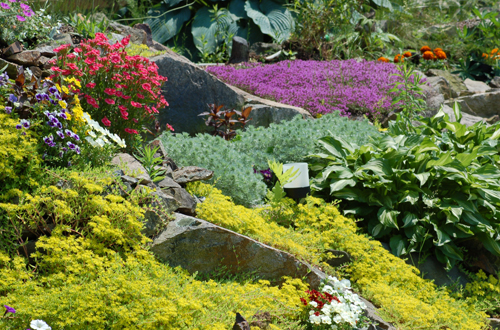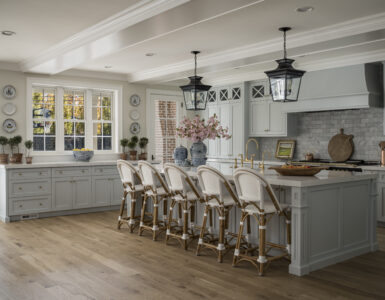Darin Engh from Engh Gardens has tips on plants to choose and how to plant them to have a garden that “rocks”.
Turn a sloping yard into an easy-care garden with rocks and the right landscaping plants. Creating a rock garden on an existing slope can turn a difficult planting area into a garden asset. Using rocks to create a series of terraces forming flat planting areas avoids the problem of erosion. Nothing beats the charm of plants cascading down a hillside. A rock garden or stone wall is a very attractive way to deal with a change in level. Plants nestled in rock crevices provide a pleasing organic beauty. Choose the right plants that will also grow in the crevices. Moisture is the key to growing plants in wall crevices. Damp walls support ferns and mosses, but walls that bake in the sun require drought-resistant sedums. Many types of plants are suitable for rock gardens. Generally, plants that are low growing and have a clumping habit are preferred.
Rock Garden Plants
1- Ajuga “Burgundy Glow” “Black Scallop” “Mahogany” Deep, rich mahogany leaves and blue flowers in spring. Heat and drought tolerant; deer resistant. Outstanding foliage plant!
2- Plumbago or Leadwort (Cerostigma plumbaginoides) Attractive foliage that starts out green and turns a vivid scarlet in cool temperatures. Showy blue flowers that attract butterflies; blooms summer to fall.
3- Lysimachia “Goldilocks” Disc-shaped, gold foliage will blanket the ground. Drought tolerant; deer resistant.
4- Grasses to add height and movement.
a. Leather Leaf Sedge (Carex buchananii) Easy to grow accent plant. Caramel-colored leaves have a curlicue top. Plant in masses among slopes.
b. ‘Karl Foerster’ (Calamagrostis acutiflora) Dramatic red-bronze flower spikes early to midsummer.
c. ‘Overdam’ Feather Reed Grass Upright. Feathery flower spikes create vertical accents and turn from reddish brown to gold in fall. Narrow foliage is variegated with creamy white vertical stripes. Deer resistant; attracts birds.
d. ‘Northern Lights’ Tufted Hairgrass (Deschampsia caespitosa) Creamy, white variegation, leaves turn pink in cold weather; good in perennial or rock gardens.
GREAT CREVICE PLANTS
For great crevice plants, look for tough plants with shallow roots.
1- Ice Plant (Delosperma) Hardy to Zone 4 Succulent, groundcover with rounded, fleshly leaves and large, golden daisies in summer. Leaves turn red in winter. Heat and drought-tolerant.
2- Hens-and-Chicks (Sempervivum) are the sparkling jewels of a crevice garden. Rosettes of plump, wedge-shaped leaves turn red in spring. Tiny star-shaped flowers complement the foliage in summer. Each mother plant “hen” produces several offshoots “chicks” per year, thus explaining this plant’s unique common name.
3- Herbs also work well. Good examples include lavender (Lavendula), and creeping thyme (Thymus).
PLANTING BETWEEN THE CRACKS
1- Find an opening. With a trowel, loosen the soil between the rocks.
2- Take the plant and knock most of soil off the roots. Then poke the roots as far into the crevice as you can.
3- Mix equal parts of sphagnum moss and soil with just enough water to make a thick slurry; the mixture should be wet and sticky. Make a plug with a handful of the mix and push it into the crack around the plant, like mortar. The mossy mix helps hold new plants in place and provides moisture while they are getting established.
For more information, you can contact Darin at Engh Gardens in Sandy or online at www.enghgardens.com















Add comment